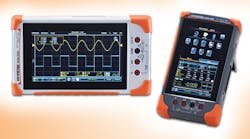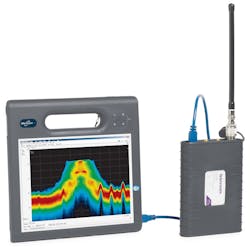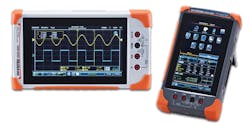Pushing their scopes and spectrum analyzers to unprecedented speeds and bandwidths, instrument makers now look to the user interface for new ideas. This ranges from rethinking the whole look and feel of traditional controls to moving the display from the front of the box to the user’s PC or tablet.
This file type includes high resolution graphics and schematics when applicable.
Displays Get a Makeover
Enhancements started with making a friendlier integral display. According to Doug Beck, Keysight usability engineer, when the company visited customers around the world to get feedback about test instruments, issues more often concerned productivity rather than measurement science. This feedback led to the new Version 5.0 user interface for the company’s Infiniium oscilloscopes. Improvements include:
• Zone trigger
• Horizontal and vertical scales
• “Grids and windows”
• Spectrum-analyzer-like FFT functions
• Fast and easy documentation
• Offline analysis
• Math and memory controls
• Temporary “handles”
• Gated measurements
• Gated FFTs
Let’s take these in order, starting with “zone trigger.” Beck says that while most scope users have no problem triggering on a rising or falling edge of simple waveforms, triggering on anything more complicated presents a challenge. Often, one engineer in the lab is the guru of advanced triggering, and he or she becomes the go-to person for measurement setups that involve “interesting” triggering situations.
The idea behind zone triggers, he says, is “if you need to trigger on anything more complicated than an edge, just draw a box.” To demonstrate, he shows the capture of a complex waveform and, using a touchpad, draws a box around the event he wants to use as a trigger. Users can define up to 10 nested zones.
Beck goes on to talk about “horizontal and vertical scales.” Traditionally, a scope user looks at an event on a scope graticule and does a quick mental subtraction—scale value minus offset—to arrive at a measurement value. Essentially, the scope labels the times and amplitude values of selected events on the horizontal and vertical axes of the display.
Next is “grids and windows,” which works with those scales. This feature becomes advantageous when looking at multiple waveforms simultaneously. The point is that those words are pluralized.
Up until now, Beck says, all scopes show their results on a single window—a leftover from the days when scopes were analog devices with a phosphorescent CRT screen. When the user separates multiple signals so that they don’t overlap, the amplitude and/or time scales of smaller-amplitude signals can be squeezed. As a result, less detail can be observed.
With the “grids” feature, users can view up to 16 full-scale, non-overlapping grids simultaneously, all using the full resolution of the ADCs that are digitizing the individual input signals. It’s also possible to overlap the grids.
The “Windows” feature targets sophisticated users who don’t want to overlap or stack waveforms. As the name suggests, the feature makes it possible to separate individual signals from multiple inputs and arrange them on the screen in different-sized (or same-sized) windows and stack them (or put them side by side). Users can also add identification tabs to them, or overlay them in whatever order provides the best understanding of what’s happening in the circuit under test.
On top of that, scope waveforms can be sent to a desk monitor that’s also displaying a protocol decode, or jitter diagrams, or eye diagrams, to produce a single composite of what’s happening in the time, frequency, and digital domains. (If this is starting to sound like “too much information to deal with when you’re just peeking at a waveform,” Beck points out that “all of these features ‘stay out of your way’ until you ask for them.”)
The Keysight FFT feature represents a “fix” for the problems of contemporary scopes that provide spectrum-analyzer-like displays of analog signals. Beck says they don’t necessarily provide frequency-domain displays that deliver information as handily as a real spectrum analyzer.
Sharing Results
The next issue addressed by Beck addresses involves documentation. This is really about sharing results. Once upon a time, a scope could simply hang a special camera on an instrument’s bezel, take a Polaroid photograph of the display, type up some notes, paste the photo on the write-up, Xerox the page, and fax it to a colleague.
Considering the information contained in a modern scope display, it may be time for something more 21st century. This isn’t a trivial issue, according to Beck. In fact, he says, it’s the number one issue brought up by users everywhere. They weren’t happy with importing screen captures into PowerPoint.
Such insight led to Keysight’s “bookmarks” feature. Essentially, bookmarks allows users to pinpoint a specific location in time on the display. The bookmark stays associated with that point no matter how one drags the display around. Similarly, embedded markers are tagged with their values and stay with the point highlighted no matter how the user scrolls the screen.
Other features also aim to share data in ways that let other engineers know what they’re looking at on the screen captures. For instance, those other engineers can do more than stare at fixed images. If they have the Keysight software, they can actually move around within the captured data, extending the analysis and marking up their interpretations for colleagues.
This, in fact, extends the utility of the scope, which is a fairly expensive piece of capital equipment. With “offline analysis,” engineers can use mathematical tools to analyze offline waveforms to an extent, as if they were working on the instrument that captured them, even when someone else in the lab is using the instrument for a different project.
The “math and memory” waveforms feature essentially means that the new scopes always show controls for all waveforms that are ON, regardless of their type. If the user is performing a math function on a waveform, its controls are on-screen, right next to the controls (like the ones that control gain and sweep) for the waveform.
The “temporary handles” feature addresses a common problem with contemporary scopes. When a user tries to grab a marker and misses, he or she winds up moving an underlying waveform instead. That’s because most markers, being one pixel wide, are hard to grab. “Temporary handles” resolves the problem by letting the scope user attach labels to markers. Then the labels can be dragged and dropped more easily than having to do so with the markers.
“Gated measurements” make it easy to perform measurements on only selected areas of a trace. Finally, the “gated FFTs” feature allows users to perform an FFT on a selected portion of a waveform and display it concurrently adjacent to the selection in the selection box.
“Pocketable” SA Talks to Tablets, Goes to 6 GHz
Speaking of spectrum analyzers, Tektronix this past November introduced the RSA306, a $3490 “pocket-size” spectrum analyzer with a frequency range from 9 kHz to 6.2 GHz (and 40-MHz real-time bandwidth). It weighs just over a pound. The instrument interfaces, via a USB cable, with Windows 7 or 8 PCs or tablets that run Tek’s SignalVu-PC software, which has been proven on the company’s scopes and analyzers for a number of years. It previously cost in the $3000 range, but the company has now made it freeware (Fig. 1).
Calling the RSA306 “pocket-size” is a bit of a stretch, but at 7.5 by 5 by 1.5 in. and weighing 1.2 lb, it will fit easily into cargo-pants pockets. That fact emphasizes the virtues of the RSA306 as a field instrument. An open API allows customers to use their own custom Windows-based interface, such as Matlab or Python, to manipulate raw data coming from the instrument.
Tektronix envisions a range of field applications whose users would benefit from an affordable combination of a handheld instrument and potent software running on a PC or laptop:
• Mobile radio network installation and maintenance: In the field, having all the capabilities of a real spectrum analyzer provides greater versatility than a dedicated tester.
• Interference hunting: For spectrum managers and regulatory agencies, the ability of the RSA306 to spot signal bursts as short as 100 μs is a powerful feature in a handheld tool.
• University lab classes: The availability of SignalVu, free on every student’s PC or tablet, coupled with a relatively low-cost, high-performance instrument, can help students become better RF and microwave engineers—it gives them hands-on experience, duplicating the performance of the spectrum analyzers they will use after graduation. Vector analysis, frequency and phase trends, and other tools allow educators to teach concepts well beyond basic frequency and amplitude.
Entry-Level Multifunction Instrument Targets “Makers”
National Instruments this past June introduced Virtual Bench, inspired by the company’s relationship with Tech Shop, the growing network of technical community resource centers for “maker” type experiences for learning and building.
VirtualBench is an all-in-one instrument that integrates a mixed-signal oscilloscope, function generator, digital multi-meter, programmable dc power supply, and digital I/O. Interaction with those tools occurs via software applications that run on PCs or iPads.
Bandwidth on the two-analog-channel scope is 100 MHz (there are 34 digital input channels). Users can add, subtract, and multiply input waveforms and perform fast Fourier transforms (FFTs). The sine- and square-wave function generator is programmable to 20 MHz and 5 MHz, respectively, and the programmable dc supply has one channel that goes to 6 V at 1 A and two that go to 25 V at 0.5 A.
Beyond the “Usual Suspects”
NI’s VirtualBench, aimed primarily at educators and experimenters, is a reminder that Saelig Company, a test-equipment distributor, has been a source for experimenters and hams since 1988. Most engineers have at least considered investing in one of its PC-connected scopes.
In the spirit of “test instruments that don’t necessarily look like they used to,” consider some recent additions to Saelig’s offerings. The GDS-200/300 series of battery-powered, compact, two-channel, 1-Gsample/s digital oscilloscopes have a 7-in. touch-panel LCD that works in portrait or landscape orientations (Fig. 2). The family includes 70-, 100-, and 200-MHz-bandwidth versions. The touch-panel LCD makes it easy to move waveforms up and down and set trigger levels. Two-point touch allows adjustments to amplitude and time settings.
The GDS scopes also incorporate built-in digital multimeters that can simultaneously measure and monitor ac or dc voltage and current, and temperature. It’s possible to save and review trend plots over time. Moreover, users can store and retrieve waveform images and raw data via USB, or connect via smartphones to transmit the recorded data to a remote location. A single unit costs $1195.
If that’s more scope than necessary, one could instead opt for a $99 USB oscilloscope-in-a-pen (Fig. 3). The Owon RDS1021 “Wave Rambler” comes with its own PC software, much like VirtualBench, but without any box between the probe and PC processing the input signals and running the display. Also, thanks to USB, there’s no need for an external power supply.
Is it practical? This scope-in-a-pen handles input-signal amplitudes from 5 to 50 V. On top of that, with the software in the attached PC, it will perform FFTs on captured waveforms.
The horizontal scale can be set between 5 ns and 100 s/div. A trackball is built into the probe top; there’s no need for the user to take his or her hands off and adjust the PC.
The Wave Rambler automatically handles peak-to peak, average, and rms voltage measurements, and will calculate frequency, period, overshoot, pre-shoot, rise time, fall time, and duty cycles. It can also show sampled, peak-detect, and average waveforms. Stable waveform triggering is obtainable via signal edge, slope, and pulse triggering.
This file type includes high resolution graphics and schematics when applicable.
The instrument measures 5.9 by 0.8 by 0.7 in., and weighs 1 oz. It comes with a ground clip, a protective cover, a CD ROM with the software, a quick-start manual, and a USB cable.




